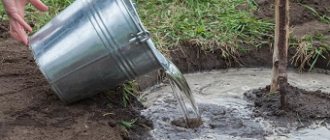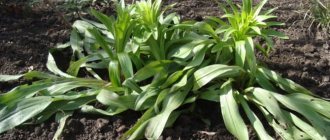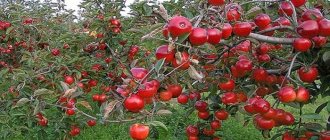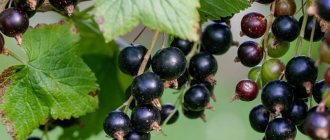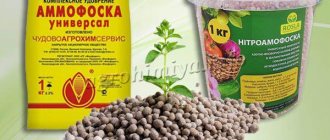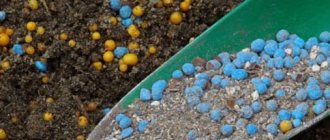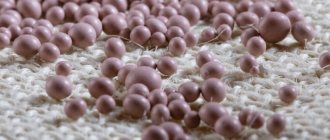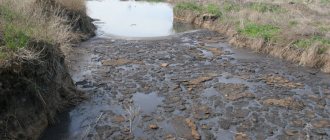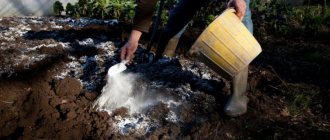The need for spring feeding of grapes
At the end of the sleep phase, in early spring the grapes take nutrition from the soil. If it is depleted, then the lack of nutrients will affect the growth and growing season of the bushes. To get a good harvest, plants need to be fertilized.
Reasons for spring fertilization:
- when receiving the optimal quantity and quality of nutrition, grape fruits are formed large and tasty;
- the inflorescences and formed clusters of grapes are preserved as much as possible;
- after difficulties in winter, it is possible to preserve and bear fruit on weak grape vines;
- feeding is a preventive measure against diseases and parasites;
- the cumulative effect lasts for 1-2 years.
The need for a microelement can be determined by the state of the green part of the grapes. This makes it possible to adjust the fertilizers.
Signs of component deficiency:
- pale green leaves and slow growth - needs nitrogen;
- brown edging of leaves - lack of potassium;
- deep green leaves with brownish-brown spots - phosphorus deficiency;
- green veins against the background of yellow leaves - you need iron;
- rotting of the base of the vine - sulfur is required.
As a top dressing, instead of chemical fertilizers, you can use organic ones, or try traditional methods of preparing nutrient solutions.
Young grapes do not need fertilizing for 3 years, provided they are applied during planting. This is due to the fact that frequent feeding of the plant does not allow it to bear fruit. It spends its energy only on the formation of the vine and root system.
Why and when is fertilizing needed?
The natural mineral reserves of the soil are quickly depleted. The gardener's job is to maintain the balance of the elements. Then the plants will acquire strong immunity, stop getting sick, and will actively develop and bear fruit.
After wintering, crops need energy for further growth. During this period, they are greatly weakened - without additional nutrition you should not expect a good harvest. Therefore, spring feeding of grapes with appropriate fertilizers is of paramount importance.
Already when planting the cuttings, organic matter is placed in the holes. This is done even in fertile areas - seedlings actively gain green mass and extract a large amount of useful substances. The plant begins to be fully fed in the third year.
Winegrowers note that thanks to timely fertilizing, productivity increases by at least 40-50%.
Fertilizer application timing
The timing of fertilization is determined by the climate of the region, so you should focus on the stage of plant growth:
- The first application - the plant is still in the sleep phase, late March-early April.
- The second application is when the embryos of the racemes appear, 10-14 days before the formation of inflorescences, the second ten days of May.
- The third application is after the formation of the ovaries, in the first days of June.
If you do not adhere to this schedule, the grapes will receive a deficiency of substances and microelements or too much of them. In each of these cases, it makes no sense to count on a harvest. But by following the rules for applying fertilizers, you can get a good harvest.
How to feed grapes in June for a good harvest
Summer feeding is of great importance. At this time, when the berries are ripe, the bush needs to provide the vines with everything they need. And at the same time, the bush itself is prevented from developing normally by weather conditions and pests. How to help the plant?
For summer feeding you need to use:
- Nitrophoska,
- Superphosphate,
- Ammophos,
- ammonium nitrate,
- Potassium salt,
- Phosphorite flour,
- Urea,
- Potassium sulfate,
- Ammonium sulfate;
- Manure,
- Bird droppings,
- Compost.
These mineral and organic fertilizers contain iron, potassium, calcium, phosphorus, sulfur, and magnesium. Read about the proportions below.
Some of the fertilizers can be applied as foliar feeding and sprayed on grape bushes.
Feeding methods
Let's look at two popular methods.
Foliar feeding of grapes
Foliar feeding can only be done in addition to root feeding. Sugar or glycerin, 40-60 g each, is added to the spraying solution along with fertilizers. When carrying out work, it is important to consider:
- Times of Day. The optimal time will be in the evening, when the dew has not yet settled and the rays of the sun are no longer dangerous.
- Weather within 24 hours after treatment. Grapes should be sprayed with fertilizer on a dry leaf, and there should be no precipitation for at least a day so that the nutritional components have time to be absorbed.
- Condition of the bush. Primary fungicidal treatment or spraying of grapes may be necessary to kill pests. If the bush is very weak, then it will be more useful to apply fertilizers using the root method.
If the plant is in satisfactory condition, foliar feeding can be combined, if necessary, with disease prevention. Then the grapes will receive both nutrients and medicinal substances at the same time.
The first spraying with phosphorus is carried out two weeks before the start of the flowering phase to feed the grapes at the time of fruit formation. This element, quickly absorbed by the leaf mass of the bush, has a positive effect within a month. Liquid consumption rate per 1 sq. m of plot is 150-200 g.
The foliar feeding mixture may contain: potassium sulfate, ammonium sulfate, zinc, boric acid, calcium sulfate and molybdate.
In addition to the main ones, foliar treatments with nutrient mixtures are done 3 more times, but the amount of phosphorus in them is reduced:
- after the formation of inflorescences;
- before the berries ripen;
- when preparing grapes for winter cold.
Watch this video about foliar feeding of grapes in the spring before flowering:
Root feeding
Root fertilizers can be liquid - all kinds of nutrient solutions and infusions, and dry - these are practically the same fertilizers, not diluted with water.
Dry fertilizers are applied during the digging process or by spreading them over the grape plot. After such work, watering is required so that the beneficial substances dissolve and reach the root system.
For wet root feeding, dig in an asbestos or plastic pipe at a distance of 50-70 cm from the base of the bush. The pipe should have a diameter of 100-150 mm and be dug to a depth of at least 40 cm. All nutrient solutions are poured into it, so they quickly reach the roots. Instead of pipes, you can dig a ditch 40-50 cm deep around the perimeter of the bush. Pour a fertilizer solution into it and cover it with soil on top.
Green fertilizer is very useful - peas are sown between rows and dug up after ripening.
What fertilizers are best to use for grapes?
The range of fertilizers for grapes in the spring to increase the yield and increase the resistance of the vine is wide, including organic and mineral compounds. Each agronomist chooses his own scheme from the presented options, based on traditional approaches and personal experience. If the vine is planted according to the rules in a prepared hole, you can do without enriching the soil for about 2 years. By the third year, the bush becomes mature enough and needs additional nutrition. Approximate vine care scheme:
- As soon as the bush opens, dig 30 cm holes along the periphery and place about 2 buckets of humus in them. The procedure is repeated once every 2 years;
- every year, before the buds bloom, 3 liters of ash are embedded in the soil around the bush;
- before flowering, the leaves are sprayed with mineral compounds according to the instructions;
- When the future berries stand out, repeat the spraying.
If it seems that fertilizing the grapes with mineral fertilizers in the spring did not satisfy the needs of the vine, you can treat the soil in the summer, but exclude nitrogen. Its excess can accumulate in berries, worsening the quality and shelf life, and makes the bunches potentially harmful for consumption. In spring, nitrogen can be safely added without exceeding the dosage recommended by the instructions. The most harmless version of a nitrogen supplement is urea. It is more convenient to use it for spraying.
By choosing which fertilizers to apply more in the spring when planting grapes, you can save a lot on potassium compounds. Wood ash is almost free for those with a stove. The vine loves potassium very much, and you will need a lot of it. Monophosphate, sulfate and potassium chloride are available. Chloride is combined with other additives except urea. Sulfate is more convenient because it is neutral to other types of additives, dissolves well and has almost no effect on the acidity of the soil. Monophosphate contains not only potassium, but also phosphorus.
Typically, complex fertilizers for grapes in the spring do not include phosphorus, since it is slightly soluble in water. The selected option in the form of phosphate rock or precipitate is ordered into the soil before winter.
In addition to the listed compounds, organic matter is actively used - manure (preferably horse manure), bird droppings (requires caution), and compost.
How to fertilize grapes in spring? Types of fertilizers and their specifics
Fertilizers saturate the soil with the nutrition necessary for the growth and development of grapes. For each application of fertilizers to the soil, a certain composition of fertilizing is required. All of them are subject to a special seasonal schedule in order to get the maximum effect in the form of a rich harvest and not harm the bushes.
In spring, single-component, complex and complex fertilizers are used.
Potash fertilizers
The main active ingredient is potassium, a vital element for grapes. Knowing that it is washed away by rain and watering, it is difficult to overestimate the role of potash fertilizers. They are chloride and sulfate.
The leaves of the bush contain a huge amount of chlorine, but with the growth of green mass and heavy rainfall, its concentration decreases. Chloride fertilizers restore and maintain the balance of this element. They must be applied carefully, since an excess of chlorine is dangerous for the grapes.
Potassium chloride is rich in potassium by 40-60%. To reduce acidity, lime should be added to it. Can be used in combination with any elements, but urea is not suitable for a mixture with potassium chloride.
Sulfuric acid fertilizers are responsible not only for the healthy development of the bush, but also affect the sugar content of grape fruits. They penetrate well into the root system with rain, so it is advisable to use them not in spring, but in autumn.
Phosphorus fertilizers
Phosphorus is an essential element for grapes during the growth and flowering stages, especially for young plants. Thanks to its balance, large, healthy fruits are formed.
You can use the following tools:
- Superphosphate consists of 20% phosphoric acid. Compatible with various soils, but if they are highly acidic, lime is added to the fertilizer. Another option is to lim the soil before fertilizing. The positive effect of superphosphate is characterized by increased productivity and immunity to diseases. For feeding, the fertilizer is diluted with water in a ratio of 1:10 and 0.5-0.7 liters are watered under each bush.
- Double superphosphate consists of a double dose of phosphorus. When diluted with water, the fertilizer rate is reduced by half. In spring and summer it is used as a liquid fertilizer, and before wintering it is sprinkled around grape bushes.
- The precipitate is rich in phosphorus by 35%. It is practically insoluble in water, so the powder is scattered over the grape plantation when loosening or weeding. Most compatible with acidic soils and gray soils.
- Defluorinated phosphate is suitable for chernozems, turf and podzolic soils. Contains 32% phosphate.
fertilizer "Superphosphate"
fertilizer "Double superphosphate"
fertilizer "Precipitate"
fertilizer “Defluorinated phosphate”
Complex and compound fertilizers
Complex fertilizers combine at least 2 elements. They are produced in 2 ways:
- One-component fertilizers are mixed together.
- Using chemical reactions of various components.
Such supplements include:
- Nitrophoska. Nitrogen content - 16%, phosphorus - 16%, potassium - 16%. It is produced in a classic form - only from these components and with the addition of elements (copper, cobalt, boron, zinc, etc.).
- Azofoska is based on three main elements - N, P and K. It is available in the form of a solution and a dry mixture. Dry fertilizer is applied into the depression around the grapes, and the liquid form of fertilizer is poured under the root.
- Bishofite consists of more than a dozen elements - magnesium, boron, iodine and bromine, etc. It is used for foliar feeding. The dilution rate is 100 ml of fertilizer per 10 liters of water.
- Florovit is a fertilizer created for grapes. It is used when planting plants and as the main root feeding. Fertilizer consumption is 50 g per plant.
- Agro-Nova - this Ukrainian fertilizer, in addition to micronutrients, contains bioadditives to stimulate the growth of grapes. In spring, it is used as a liquid root dressing. To do this, 90 g of fertilizer is dissolved in 10 liters of water. For the leaf application option, it is diluted in water in a ratio of 1:100.
fertilizer "Nitrophoska"
fertilizer "Azofoska"
fertilizer "Bishofite"
fertilizer "Florovit"
fertilizer "Agro-Nova"
Organic fertilizers
Animal waste products and plant waste decompose into substances that are useful and easily accessible to plants. Organic fertilizers have their pros and cons.
Benefits of organics:
- There are no material costs in their production, because they are natural free supplements for farming.
- They contain a balance of essential nutrients and microelements necessary for grapes.
- The activity of bacteria during the decomposition of organic matter has a beneficial effect on the soil. Air permeability and the ability to retain moisture increase, which has a beneficial effect on the development of the vineyard.
Disadvantages of organics:
- The composition of organic fertilizers is not exactly known to the gardener. This makes it difficult to determine the deficiency or excess of substances in plants. The composition of mineral fertilizers is indicated on the packaging or instructions for use.
- When adding organic matter, it is possible to infect grapes with diseases, or transfer larvae and adults of pests, as well as weed seeds.
- Hygiene and aesthetics make it difficult to work with such fertilizers.
The most popular organic fertilizers are compost, manure and bird droppings.
Manure is the waste products of animals, their excrement. When fresh it contains a large amount of nitrogen. This makes it impossible to use it in concentrated form when planting young grape bushes due to the possibility of causing burns to the root system.
For application, manure is diluted with water in a ratio of 1:10. In spring, humus is used. Manure, which has been rotted for at least 2-3 years, is used to fertilize planting holes and already growing bushes by digging up the soil.
You should not uncontrollably apply manure to the soil, as there may be an excess of nitrates in it. Especially often such a negative result appears on black soil. Lighter and more porous types of soil allow water to pass through well and are washed out by precipitation and watering. Therefore, in order to receive only undeniable benefits from the use of manure on the land, you need to carefully and responsibly approach the process of feeding grapes.
Compost is prepared by mixing grass clippings, household organic waste, leaves of trees and shrubs with soil or peat. The mixture is moistened and stirred periodically to saturate it with oxygen. After a year or two, a valuable fertilizer containing a rich nutritional composition for plants is obtained.
If healthy plant residues were used when preparing the fertilizer and no manure was added, the absence of pathogens and pest larvae is almost 100%. Humus is suitable for root fertilization of grapes and for preparing planting holes.
Bird droppings are used dry or dissolved. It is poured in small quantities into the depressions around the perimeter of the bush, sprinkled with soil. To prepare the solution, dilute a handful of chicken manure with 5 liters of water. Leave in a warm place for 7-10 days, stirring occasionally. Dilute this infusion again with water in a ratio of 1:10. Pour the fertilizer along the rows, taking into account that 500 ml of liquid is required for 1 bush.
The video below will talk about adding bird droppings to grapes:
Do not pour a solution of chicken manure under the bush. This can cause burns to the roots.
Before fertilizing and after its completion, carry out measures to water the area.
Folk remedies
One of the popular and effective folk supplements is yeast. It is prepared in several steps:
- Dissolve dry baker's yeast in warm water in a ratio of 1:1000.
- For each liter of solution, add 1 tsp. granulated sugar.
- Let it brew for 2-3 hours.
- Before use, dilute with clean water in a ratio of 1:5.
This solution can also be prepared using live yeast, but then do not add sugar. The consumption rate for this fertilizer is 2 liters per bush.
Ash is the most suitable organic-based mineral fertilizer for grapes. It nourishes the plant and prevents diseases of grapes and their pests. It is especially important on acidic soils, as it perfectly reduces their acidity. Burning hardwood produces ash rich in potassium. Coniferous fertilizer contains mainly phosphorus.
In dry form, ash is used in unlimited quantities when digging and loosening areas. For root feeding, prepare an ash solution:
- add 250-300 g of ash to 10 liters of water;
- let it brew for a week;
- water the grapes, making grooves around the bush;
- liquid consumption - 5 liters per bush;
- a solution of ash is also used to spray the above-ground parts of the plant.
An experienced gardener in his video talks about feeding grapes with ash:
Egg shells are rich in potassium, magnesium, and phosphorus. But 95% of its composition is occupied by calcium compounds. All components, getting into the soil, quickly transform into a form that is quickly absorbed by grapes. To preserve the shell, you need to wash it thoroughly and dry it. Before applying this fertilizer to the soil, grind it to obtain a powder.
More about feeding with eggshells is written here.
Green fertilizer is prepared from weeds, residues of garden plants after thinning and weeding, etc. For this:
- Place the mass of greens in a container, filling it 3/4 full.
- Pour water until it completely covers the vegetable mixture.
- Cover the container with plastic, making several small holes on top.
- Let it brew until the smell of fermentation appears (10-14 days).
- Dilute with water to fertilize grapes using the root method - divide the entire volume into 10 fertilizing applications.
By adding wood ash to the solution and straining, you can use it to spray the bushes.
Fertilizing seedlings during planting
In order for the plant to quickly take root in a new place and begin to grow, a young grape seedling needs a push, in the form of a one-time supply of nutrients when planted on the site. The composition of the mineral cushion has a direct impact on the success of the entire crop cultivation procedure, which is why it is so important to take care of the availability of easily digestible mixtures. A good option would be a mixture of two buckets of humus, manure or chicken droppings, with the addition of 100 g of nitroammophoska. Before placing it in the planting hole, the fertilizer is left to ferment for 2-3 days, using only rotted material as organic matter. In terms of the composition of nutrients, the finished substrate will resemble humus, which is well suited not only for grapes, but also for other garden or vegetable crops.
If the soil is maximally saturated with vitamins and minerals during planting, the next time you can ask the question of fertilizing no earlier than after 2-3 years of growing the crop on the site.
Timely fertilization is a prerequisite for the rapid growth and development of the vineyard. What exactly to feed the vine in the spring is up to each gardener to decide for himself, but to obtain a positive result, it is important to alternate the use of organic and mineral compounds, adhering to the recommended application schedule.
How to feed grapes to increase yield?
It is important to carry out fertilizer application activities taking into account their characteristics. In order for the substances to quickly reach the main root system, a depression is made around the bush in the shape of a circle with a radius of 25-80 cm (depending on the size of the bush) and a depth of about 40 cm. All fertilizing solutions are poured onto the area of the dug circle.
Humus and slurry are distributed over the surface of the circle, and then digging is carried out 15 cm deep. After such loosening, the top dressing should be covered with a soil layer.
Popular mistakes
Beginning gardeners often make mistakes in spring fertilizing due to inexperience. The most popular mistakes:
- Scattering dry fertilizers over the soil surface. In such cases, evaporation of nitrogen is inevitable, and potassium and phosphorus do not have the opportunity to get through to the root system of the grapes.
- Uncontrolled application of fertilizers. This leads to painful bushes and reduced yield.
- Apply fertilizer only to areas with young grapes. Provided that planting holes have been formed with fertilizing, the grapes do not require other fertilizers for up to 3 years. Adult bushes, on the contrary, experience a deficiency of microelements and nutrients as they grow.
Mineral
Feed until buds appear
Gardeners also use minerals to feed grapes in the spring.
They should be used with extreme caution, observing the dosage. Since industrial chemicals can cause great harm to plants - it inhibits their growth or even provokes death. For the regions of the middle zone, it is recommended to feed the plants four times during the entire growing season; in the southern regions, three feedings are sufficient.
First feeding
The first spring feeding of grapes is carried out even before the beginning of the growing season - until the buds open. Typically this procedure occurs in April-May.
For this period, the following composition is used:
- phosphate fertilizers - 50 g;
- potassium - 35 g;
- nitrogenous - 45 g.
A dry mixture of fertilizer for grapes is made in early spring and applied to holes dug around the bush at a half-meter distance from the trunk. This way the root of the plant will receive the maximum amount of nutrients. After this, the fertilizer is sprinkled with earth.
Also, the first feeding of grapes in the spring before the buds open can be carried out with the drug Rastvorin. First, it is diluted in a ratio of 1:20 l. They dig out holes, water them abundantly with water, then pour in a nutrient solution, and then water again.
Second feeding
The second spring feeding for grapes is carried out a few days before the seedlings or adult bushes bloom - in the summer or at the end of May, depending on the region where the bushes are grown.
Fertilizer consists of organic and mineral components. A ready-made solution of mullein or bird droppings is used as a natural fertilizer. Mineral fertilizers consist of the following components:
- potash - 30 g;
- phosphate - 50 g;
- nitrogenous - 40 g.
All components are mixed and dissolved in a bucket of water.
Organic and mineral components can be used together, provided that the dose of the latter is halved.
Third feeding
It is carried out during the period of mass appearance of pea-sized berries.
Use complex fertilizers. Use 30 g of the drug per bucket of water. Such nutrition is necessary to increase yield. If you follow the dosage and apply complex fertilizing correctly, the yield will double.
Fourth feeding
To feed the bushes at the initial stage of berry ripening, two components are used - phosphorus and potassium. For those who prefer natural fertilizers, potash fertilizers can be replaced with wood ash obtained from burnt branches of fruit trees or the same grapes.
Useful tips
In order for grapes to produce a rich and tasty harvest, you should listen to the following recommendations:
- Before and after applying root fertilizers, it is necessary to water the grapes. This will dissolve the components of the bait and make it easier for the roots to access them.
- Dry forms of fertilizers and nutrient solutions for irrigation should not be applied to the surface of the earth, but into depressions made along the perimeter of the bushes or in the inter-row spaces.
- If necessary, use spraying in combination with the root method of fertilizing.
- Carefully monitor the schedule and rates of fertilizing.
Methods of applying fertilizers depend on their composition, weather and condition of the bushes. Rational, responsible fertilization of a grape plot will help you get a rich harvest even on seemingly hopeless land.
1
0
Copy link
How and what to feed grapes after flowering in July
To obtain tasty, sweet grapes, you need to fertilize the bushes with potassium-phosphorus fertilizers. One of the options for complex root feeding:
- Dissolve superphosphate (100g) and potassium sulfate (50g) in a bucket of water. This type of feeding is important before the ovaries appear.
- Mix ammonium nitrate (20g) with Calimagnesia and dissolve this mixture in 10l of water. When the berries develop.
- An infusion of wood ash can be used in any period after the vines flower.
- Mix superphosphate (20g) with fertilizer, which has a potassium composition, and dilute it in a bucket of warm water. A week before the grapes ripen.
Foliar feeding:
- Dissolve boric acid (5g) in water (10l). Spray the bush with the solution. A few days before flowering.
- 7 days after the start of flowering, spray the bush with phosphorus-containing fertilizer. And repeat the procedure after 2 weeks.
- Potassium and superphosphate fertilizers are used for feeding.
These feeding schemes will help you get the most abundant harvest of sweet grapes.
